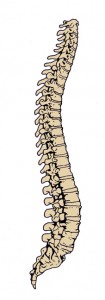The Spine Lengthens in Two Directions
The quality of our life revolves around the quality of our spine.
The alignment of our spine determines a great deal about how the body’s nervous system can flow through the body.
The nervous system is the body’s information gatherer, storage center and control system.
Its function is to collect information about external conditions in relation to the body’s internal state, to analyze this information, and to initiate the proper response.
The Central Nervous System (CNS) includes the brain and spinal cord, which is housed inside the spinal column. The Peripheral Nervous System (PNS) connects the CNS to other parts of the body, and is composed of nerves that emanate from the spinal column.
Like I said above, the skeletal alignment of our spine is the key determinant of our access to the body’s energetic resources.
To unlock this energy we must balance the curves of the spine and lengthen them in two directions; the sacrum and tailbone move down, and the lumbar spine and everything above extends up.
The problem is in the way this effort is taught.
For whatever reason, and I’m not sure when it started, exercise instructors of all types, tell their clients and students to tuck the pelvis under to get get better length in the lumbar spine.
Unfortunately, I think this is the worst instruction someone can give to someone looking for better spinal alignment.
We want to learn to lengthen the spine, while maintaining all of its natural curves, in order to pull the spinal column to its maximum length.
But to get the spine to lengthen in two directions it is essential that we lengthen the spine correctly.
In order to visualize a healthy lengthening of the spine we need to understand the muscles that are involved in this action.
Your pelvic floor is a group of muscles called the levator ani, the elevator of the anus. Energetically this muscle moves upward to the core of the body.
Your buttocks muscle, the big gluteus maximus, is a muscle that wraps down the leg to extend it.
Energetically it flows down to the earth.
These muscles (levator ani & gluteus maximus) have specific functions that work in opposition to each other.
Unfortunately this is rarely the environment in which we live because we tend to overuse the buttocks and under use the pelvic floor and as a result the spine can begin to suffer.
Relax Your Butt
Overuse of the buttocks tends to shut down energetic movement through the spine.
In standing, the gluteus maximus shouldn’t work too much.
In walking on a flat surface it works to assist the push off of the back leg. But it really kicks into gear when you are walking up hill.
Unfortunately, our posture usually shifts the buttocks into a different role. If your legs are underneath your pelvis the butt can do less.
If the thighs begin to sink forward and the pelvis tucks under— as they do in most people— the quadriceps (big thigh muscles) and the buttocks begin work to provide stability.
This false sense of stability results in the butt gripping and its energy moving upwards.
Releasing the buttocks opens the possibility for one of the body’s most important features: toning the tailbone, or pelvic floor.
Toning your pelvic floor creates the upward energy that allows for the sacrum and the tailbone to move down.
If the idea of toning your pelvic floor doesn’t make sense you can try to feel it in many ways. Holding in your pee, gently engaging between the anus and the genitals and lastly if all else falls squeeze the anus to get a sense of movement at the base of the pelvis.
Ideally you will feel a shift in the bones as well as the muscles.
Your coccyx (tail) bone at the very base of the spine should move forward ever so slightly towards the pubis or front of the pelvis as the sacrum lengthens down.
Add to this a gentle tone of the abdominals and a lengthening from the back of the throat (hyoid bone) and the neck pulls the spine up into its full extension at the top.
The key aspect of this is that though the spine is moving in two directions to find its length, the muscular action is all about lifting or lengthening up.
When the pelvic floor tones, the sacrum and tailbone moves down and when the abdominals tone as well, the spine begins to lengthen up with the help of the erector muscles in the back.
When the relationship between the buttocks and the pelvic floor is not harmonious the spine will only lengthen in one direction, usually from the lower back and above and the nervous system’s access to everything below the lumbar spine is diminished.

